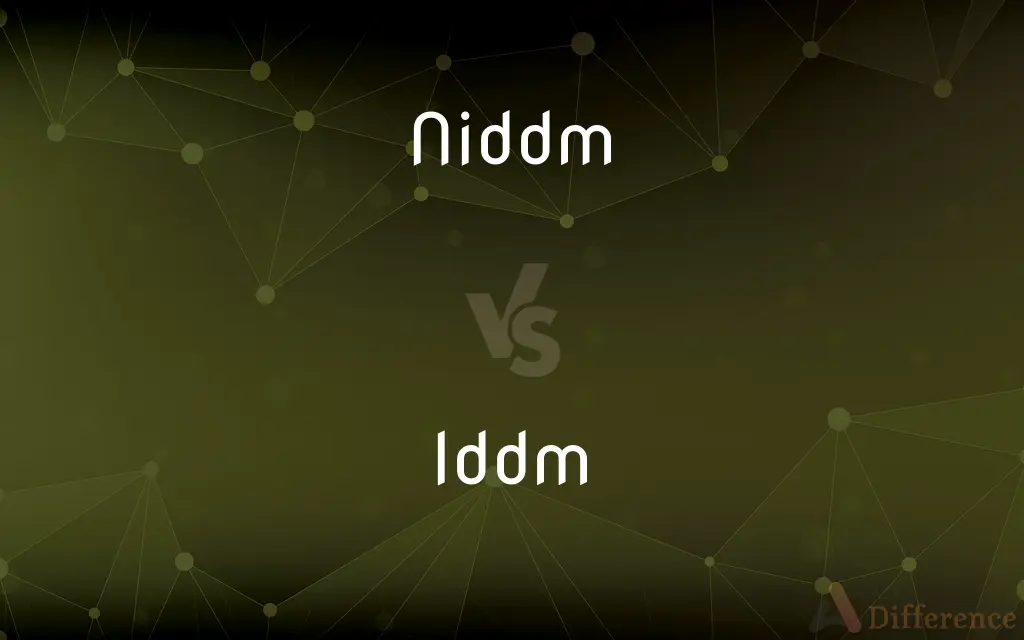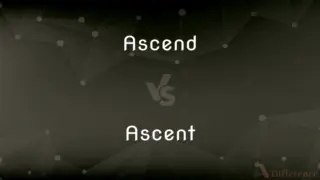Niddm vs. Iddm — What's the Difference?
By Maham Liaqat & Fiza Rafique — Updated on April 7, 2024
NIDDM (Non-Insulin Dependent Diabetes Mellitus) is managed through diet and medication, while IDDM (Insulin Dependent Diabetes Mellitus) requires insulin injections.

Difference Between Niddm and Iddm
Table of Contents
ADVERTISEMENT
Key Differences
NIDDM, now more commonly referred to as Type 2 diabetes, typically develops in adulthood and is characterized by the body's inability to efficiently use insulin. This form of diabetes is often associated with obesity and a sedentary lifestyle, and its management focuses on diet, exercise, and oral medications to improve insulin sensitivity. Whereas IDDM, known as Type 1 diabetes, usually manifests in childhood or adolescence and is an autoimmune condition where the pancreas produces little to no insulin, making insulin injections or pumps a necessity for survival.
While NIDDM patients might eventually require insulin therapy as the disease progresses or in cases of severe insulin resistance, IDDM patients depend on insulin therapy from the onset of their condition. This fundamental difference in treatment underscores the distinct nature of each condition and the body’s ability to produce and use insulin.
The cause of NIDDM is multifactorial, involving genetic predisposition combined with lifestyle factors such as diet and physical activity levels. Conversely, IDDM is primarily caused by an autoimmune destruction of insulin-producing beta cells in the pancreas, with genetic and environmental factors playing a contributory role.
Both NIDDM and IDDM have significant health implications, including the risk of cardiovascular diseases, kidney damage, and neuropathy. However, their management strategies differ fundamentally due to their underlying causes and the body's ability to produce insulin. While lifestyle modifications play a crucial role in managing NIDDM, the management of IDDM is critically dependent on insulin replacement therapy.
Comparison Chart
Insulin Dependence
Managed with diet, exercise, and medication.
Requires lifelong insulin injections or pump therapy.
ADVERTISEMENT
Onset
Typically adult onset.
Usually develops in childhood or adolescence.
Cause
Insulin resistance and relative insulin deficiency.
Autoimmune destruction of insulin-producing cells.
Management
Focuses on improving insulin sensitivity and lifestyle changes.
Dependent on insulin therapy for glucose regulation.
Common Treatments
Oral hypoglycemics, diet modifications, and exercise.
Insulin injections, carbohydrate counting, and diet.
Compare with Definitions
Niddm
Managed with lifestyle changes and oral medications.
Oral medications have significantly improved his NIDDM management.
Iddm
Commonly diagnosed in children and teenagers.
Diagnosed with IDDM at 7, she learned insulin management early.
Niddm
The body produces insulin but uses it ineffectively.
Despite producing insulin, her NIDDM results from her body's inability to use it effectively.
Iddm
An autoimmune disease where the pancreas produces little to no insulin.
Since childhood, he has managed his IDDM with insulin therapy.
Niddm
Strongly linked to obesity and inactivity.
Reducing obesity significantly lowers NIDDM risk.
Iddm
The pancreas cannot produce sufficient insulin.
Her IDDM requires daily insulin injections due to no insulin production.
Niddm
A form of diabetes characterized by insulin resistance and relative insulin deficiency.
He manages his NIDDM with a balanced diet and regular exercise.
Iddm
Associated with genetic and environmental factors.
A viral infection triggered his IDDM despite no family history.
Niddm
Usually diagnosed in adults over 30 years.
She was diagnosed with NIDDM at 45, a typical age for onset.
Iddm
Requires lifelong insulin therapy.
Continuous glucose monitoring has revolutionized his IDDM treatment.
Niddm
Mild form of diabetes mellitus that develops gradually in adults; can be precipitated by obesity or severe stress or menopause or other factors; can usually be controlled by diet and hypoglycemic agents without injections of insulin
Common Curiosities
How is IDDM different from NIDDM in terms of insulin?
IDDM requires insulin injections for survival due to the body's inability to produce insulin, whereas NIDDM can often be managed through lifestyle changes and oral medications.
Is it possible for NIDDM patients to become insulin dependent?
Yes, some individuals with NIDDM may eventually become insulin dependent if their pancreas produces less insulin over time or if their insulin resistance worsens.
What does NIDDM stand for?
NIDDM stands for Non-Insulin Dependent Diabetes Mellitus, commonly known as Type 2 diabetes.
Can IDDM be prevented?
Currently, there's no known way to prevent IDDM, as it's largely due to genetic and autoimmune factors.
What are the main causes of NIDDM?
The main causes include obesity, lack of physical activity, and genetic factors contributing to insulin resistance.
What are the symptoms of IDDM?
Symptoms include frequent urination, excessive thirst, hunger, weight loss, and fatigue.
How often do IDDM patients need to take insulin?
IDDM patients typically need multiple insulin injections daily or a continuous infusion through an insulin pump.
What are the complications associated with NIDDM?
Complications can include heart disease, kidney damage, eye issues, and neuropathy.
What lifestyle changes are recommended for managing NIDDM?
Recommended changes include a healthy diet, regular exercise, and weight management.
Is there a cure for IDDM?
There's currently no cure for IDDM, but it can be managed effectively with insulin and lifestyle adjustments.
Can diet and exercise alone manage IDDM?
While diet and exercise are important for overall health, they cannot replace insulin therapy in IDDM management.
What is the role of genetics in NIDDM?
Genetics play a significant role in an individual's risk of developing NIDDM, along with lifestyle factors.
Share Your Discovery

Previous Comparison
Ascend vs. Ascent
Next Comparison
Inkscape vs. IllustratorAuthor Spotlight
Written by
Maham LiaqatCo-written by
Fiza RafiqueFiza Rafique is a skilled content writer at AskDifference.com, where she meticulously refines and enhances written pieces. Drawing from her vast editorial expertise, Fiza ensures clarity, accuracy, and precision in every article. Passionate about language, she continually seeks to elevate the quality of content for readers worldwide.














































